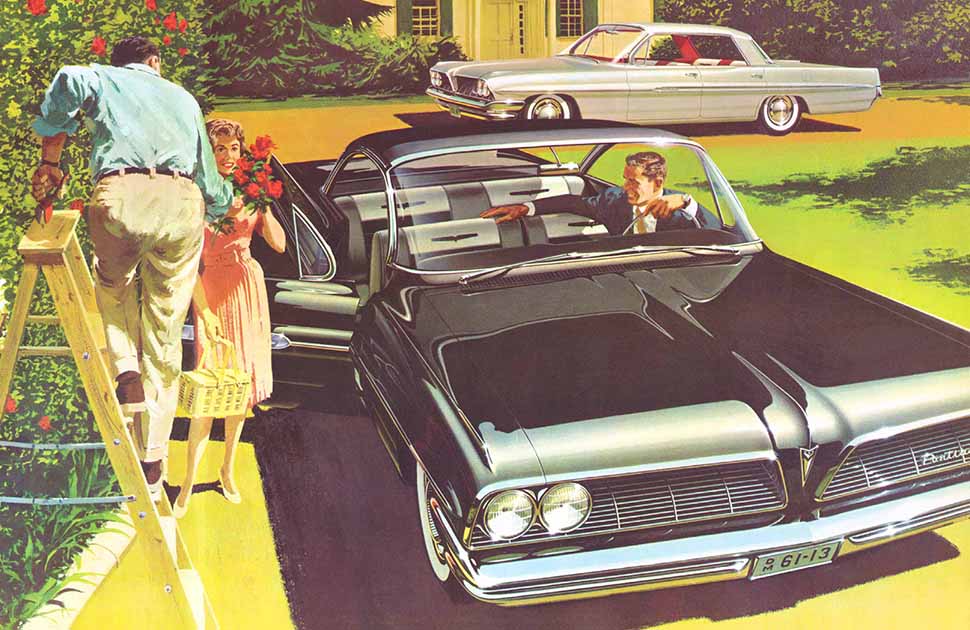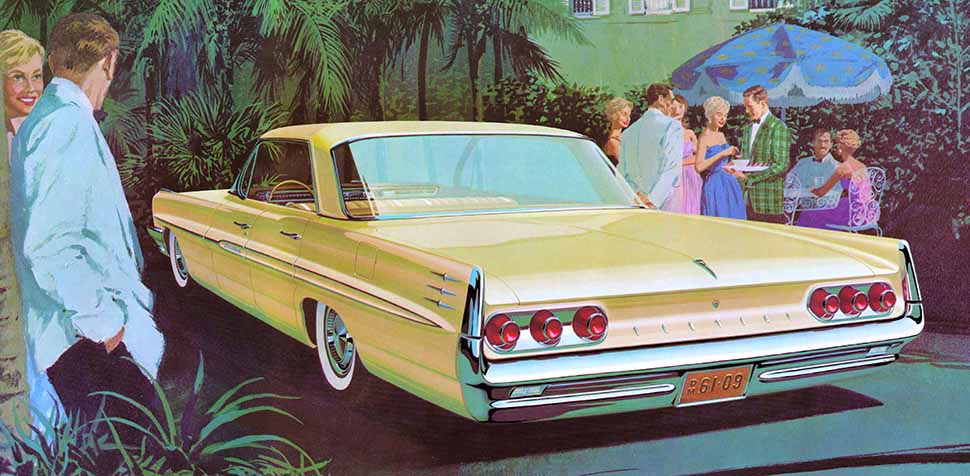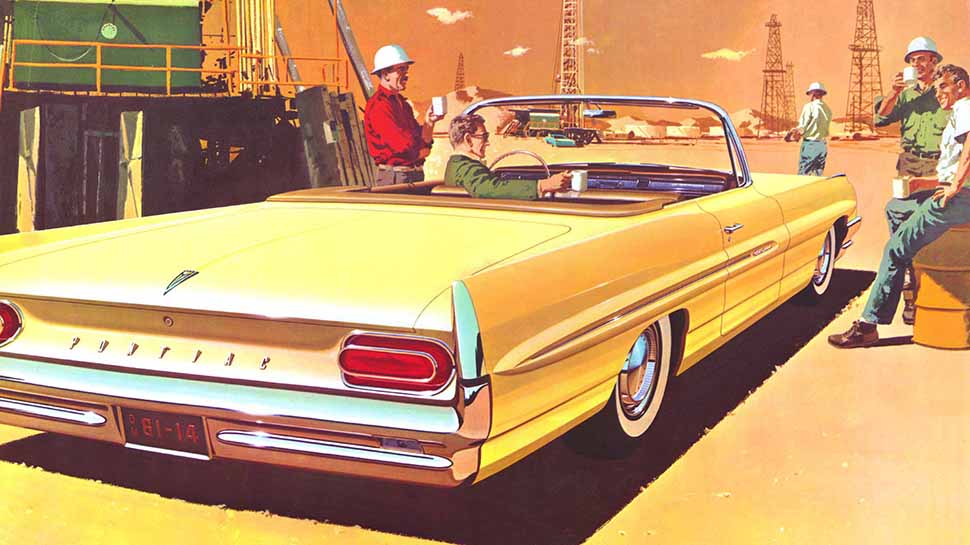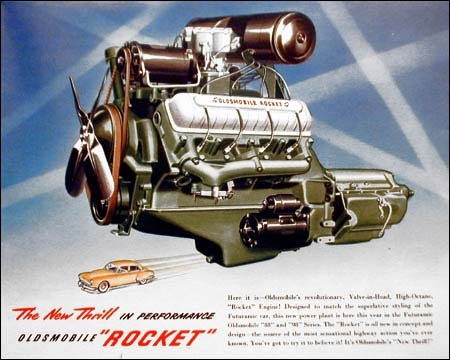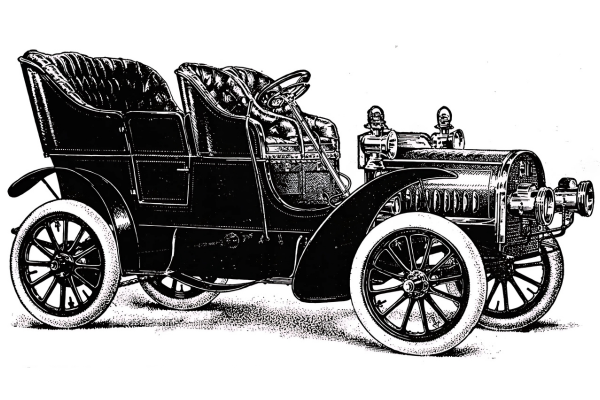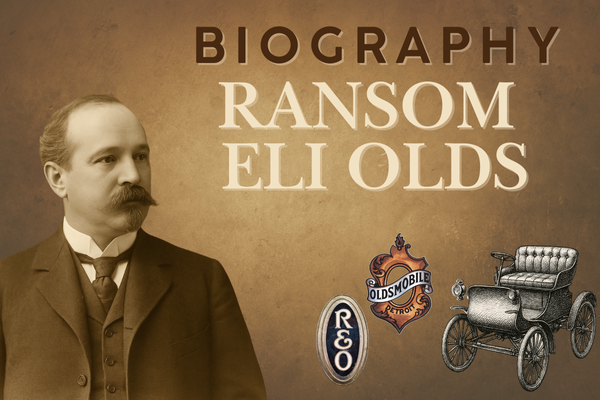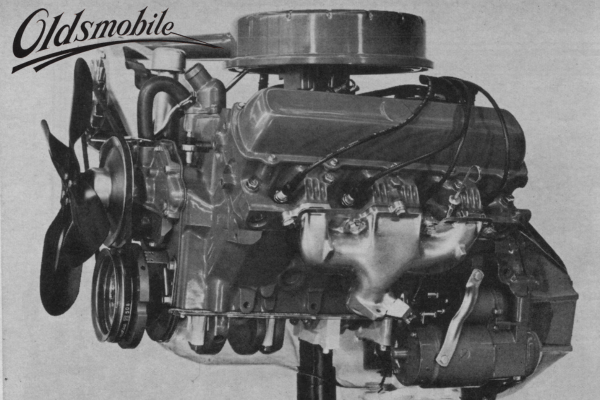General Year Information
Full-Size Pontiacs
Downsizing was the theme for the full-size models this year. Thanks to a new perimeter frame design, the bodies on standard sized cars were smaller with a 119/123″ wheelbase and lighter in weight. The Vista models featured new rooflines that emulated a convertible with the top up while the sport Coupes retained the “bubble top” look. The 2- and 4-door sedans used the old Vista roofline but were pillared.
A total of 113,354 Catalinas were built. Of these, 6,337 had Synchromesh and 107,017 had Hydra-Matic. Of the 27,209 Venturas built, 1,940 had Syncromesh and 25,269 had Hydra-Matic. Finally, 29,581 Star Chiefs were delivered, and, of these, 130 had Synchromesh and 29,451 had the Hydra-Matic.
The New Tempest Mid-Size
A radically new compact named the Tempest was introduced as Pontiac’s entry in the growing small-car market. The newly-introduced Tempest was technically innovative featuring an integral body and frame, flexible “rope” drive-shaft (think pole vault pole), independent rear suspension, rear mounted transaxle, and a four-cylinder base powerplant created by cutting a 389 cubic inch V-8 in half. An aluminum 215 CID V-8, sourced from Buick, was also an available option in the Tempest. The Tempest received Motor Trend Magazine’s coveted Car of the Year award.
A total of 98,779 Tempests with four-cylinder engines were built. Of these, 26,737 had Synchromesh and 72,042 had Hydra-Matic attachments. A total of 2,004 Tempests were built with the optional Buick aluminum V-8. Of these, only three vehicles had Synchromesh and 2,001 had Hydra-Matic transmission.
Footnotes
The four-speed manual floor mounted transmission was an available option in all Pontiacs, including the new Tempest. In the large cars, bucket seats were available only in the Bonneville convertible.
Production again decreased year-over year, this time from 1960’s 370,701 to 1961’s 340,250. Significantly, without the Tempest, production would have been the lowest since the disaster year of 1958. The consumer was not convinced that large cars were the answer.
Chassis Information
- Wheelbase: Series 21 – 112″ Series 23, 25 and 27 – 119″, Series 26 and 28 – 123″.
- Overall length: Series 21 – 189.3″ Series 23 and 25 – 210.0″, Series 23 Safaris and 27 – 209.7″, Series 26 and 28 – 217.0″.
- Front tread: (All Full-Size) 62.5″, (Tempest) 56.8″.
- Rear tread: (All Full Size) 62.5″, (Tempest) 56.8″
- Tires: Full-Size Coupes and Sedans 8.00 x 14, Station Wagons & all w/Air conditioning 8.50 x 14, All Tempests 6.00 x 15.
Models Offered
SERIES 21
The Tempest was designed to look pure Pontiac. It featured twin grilles, sculptured body panels, a V-contour hood, and body-side wind splits. Standard equipment included electric wipers, turn signals, dual sun visors, and five tubeless blackwall tires. A four-door sedan and a “Safari” station wagon were first to be offered, but they were joined by a pair of two-door sport coupes later in the year – one a “DeLuxe” trim model, with bucket seats, named “LeMans”.
SERIES 23
A major design difference in the Catalina from 1960 to 1961 was a look that would say “Pontiac” well into the 70s. This included a return to the twin grille styling themeom 1959, sculptured side panels, taller rooflines, and squared-off bodies with small tail fins added. As usual, adornment on Catalinas was left to minimal chrome and no medallions. The Catalina was fitted with single horizontal-oval tail lamps and utilized small hub caps. Standard equipment on Catalinas included turn signals, oil filter, cigarette lighter, sun visors, electric windshield wipers, and five tubeless blackwall tires.
SERIES 25
The Ventura was a Catalina with Custom level trim inside and out. Identification included chrome outline moldings for side spears, “Ventura” in script inside the bright metal spear on the door, and bright metal roof drip moldings. Venturas carried two round tail lamps and full DeLuxe wheel discs. Interiors were trimmed in three-tone Jeweltone Morrokide. Standard equipment included all Catalina equipment plus custom steering wheel, electric clock, and right-hand ash tray.
SERIES 26
Star Chiefs were outwardly identified by chrome outline moldings on the concave portion of the side spears that encircled “Star Chief” in script on the front door. Thin horizontal moldings were placed on the convex section of the spear, three chrome stars stacked on the side of the fins, and triple taillights on each side. Interiors were finished in Jacquard woven cloth with metallic highlights accented by Jeweltone Morrokide. Standard equipment included everything found in Venturas and Catalinas plus two-speed wipers.
SERIES 27
The Bonneville Custom Safari wagon was a separate series. It was built using the Catalina platform, but with Bonneville power plants and interior appointments. Most of the trim and equipment was as fitted to the Bonneville line, but the four-door station wagon had unique rear fender “Safari” in script, vertical tail lamps, and a circular keyhole ornament on the tailgate.
SERIES 28
Bonnevilles were distinguished by golden “Bonneville” nameplates on the left-hand grille, bright metal moldings on side spears, and “Bonneville” in block letters on the convex portion of the spears where the front fenders and doors met. Triple tail lamps set into bright metal housings identified the car from the rear. Upholstery ranged from nylon and Morrokide combinations on closed cars to all-Morrokide on convertibles, with full genuine leather trims optional. Standard equipment included everything found on Star Chiefs plus rear foam cushions, padded instrument panel, and courtesy lamps.
Engines
- 110 HP
- 120 HP
- 140 HP
- 155 HP AMT
- 155 HP SMT
- 155 HP V8
- 215 HP
- 230 HP
- 235 HP
- 267 HP
- 283 HP
- 287 HP
- 303 HP
- 318 HP
- 333 HP
- 348 HP
- 421 SD
- NOTES
Tempest Base I-4: Overhead valves. Cast iron block. Displacement: 194.5 CID. Bore and stroke: 4.06″ x 3.75″. Compression ratio: 8.6:1. Horsepower: 110 @ 3800 RPM. Torque: 190 @ 2000 RPM. Five main bearings. Hydraulic valve lifters. Camshaft Duration: Intake 252°, Exhaust 252°, Overlap 38°, Lift 0.330″. Carburetor: (synchromesh) Rochester one barrel Number 7019061 (automatic) Rochester one-barrel Number 7019062.
Tempest High Compression Synchromesh I-4: Overhead valves. Cast iron block. Displacement: 194.5 CID. Bore and stroke: 4.06″ x 3.75″. Compression ratio: 10.25:1. Horsepower: 120 @ 3800 RPM. Torque: 202 @ 2000 RPM. Five main bearings. Hydraulic valve lifters. Camshaft Duration: Intake 252°, Exhaust 252°, Overlap 38°, Lift 0.330″. Carburetor: Rochester one-barrel Number 7019061.
Tempest High Compression Automatic Transmission I-4: Overhead valves. Cast iron block. Displacement: 194.5 CID. Bore and stroke: 4.06″ x 3.75″. Compression ratio: 10.25:1. Horsepower: 140 @ 4400 RPM. Torque: 207 @ 2100 RPM. Five main bearings. Hydraulic valve lifters. Camshaft Duration: Intake 273°, Exhaust 282°, Overlap 55°, Lift 0.400″. Carburetor: Rochester one-barrel Number 7019062.
Tempest High Compression High Output I-4: Overhead valves. Cast iron block. Displacement: 194.5 CID. Bore and stroke: 4.06″ x 3.75″. Compression ratio: 10.25:1. Horsepower: 155 @ 4800 RPM. Torque: 215 @ 2800 RPM. Five main bearings. Hydraulic valve lifters. Camshaft Duration: Intake 273°, Exhaust 282°, Overlap 55°, Lift 0.400″. Carburetor: Rochester 4-barrel Number 7019066.
Tempest High Compression High Output I-4: Overhead valves. Cast iron block. Displacement: 194.5 CID. Bore and stroke: 4.06″ x 3.75″. Compression ratio: 10.25:1. Horsepower: 155 @ 4800 RPM. Torque: 215 @ 2800 RPM. Five main bearings. Hydraulic valve lifters. Camshaft Duration: Intake 280°, Exhaust 280°, Overlap 60°, Lift 0.380″. Carburetor: Rochester 4-barrel Number 7019079.
Tempest Optional V-8 – All Transmissions: Aluminum Block. Displacement: 215 CID. Bore and stroke: 3.50″ x 2.80″ Compression ratio: 8.8:1. Horsepower: 155 @ 4600 RPM. Torque: 220 @ 2400 RPM. Carburetor: Rochester two-barrel (Synchromesh) 7019863, (Automatic) 7019860.
Catalina, Ventura and Star Chief Economy V8 – Synchromesh Transmission: Overhead valves. Cast iron block. Displacement: 389 CID. Bore and stroke: 4.0625″ x 3.750″. Compression ratio: 8.6:1. Horsepower: 215 @ 3600. Torque: 390 @ 2000 RPM. Five main bearings. Hydraulic valve lifters. Camshaft Duration: Intake 252°, Exhaust 252°, Overlap 38°, Lift 0.330″. Carburetor: Rochester 2GC two-barrel Model 7019060.
Catalina, Ventura, Star Chief, Bonneville and Bonneville Wagon Economy V-8 – Hydramatic Transmission: Overhead valves. Cast iron block. Displacement: 389 CID. Bore and stroke: 4.0625″ x 3.750″. Compression ratio: 8.6:1. Horsepower: 230 @ 3600. Torque: 390 @ 2000 RPM. Five main bearings. Hydraulic valve lifters. Camshaft Duration: Intake 269°, Exhaust 270°, Overlap 49°, Lift 0.370″. Carburetor: Rochester 2GC two-barrel Model 719071.
Bonneville and Bonneville Wagon V8 – Standard Transmission (Optional All Others): Overhead valves. Cast iron block. Displacement: 389 CID. Bore and stroke: 4.0625″ x 3.750″. Compression ratio: 8.6:1. Horsepower: 235 @ 3600. Torque: 402 @ 2000 RPM. Five main bearings. Hydraulic valve lifters. Camshaft Duration: Intake 252°, Exhaust 252°, Overlap 38°, Lift 0.330″. Carburetor: Carter AFB four-barrel Model 3123S.
Optional 318 Horsepower V-8 – All Models , All Transmissions: Overhead valves. Cast iron block. Displacement: 389 CID. Bore and stroke: 4.0625″ x 3.750″. Compression ratio: 10.75:1. Horsepower: 318 @ 4600 RPM. Torque: 430 @ 3200 RPM. Five main bearings. Hydraulic valve lifters. Camshaft Duration: Intake 273°, Exhaust 282°, Overlap 55°, Lift 0.400″. Carburetors: three 2-barrel Rochester carburetors: (front) 7013063 (center Synchromesh) 7019064 (center Hydramatic- Catalina & Ventura) 7019069 (center – Star Chief, Bonneville & Wagon) 7019067, (rear) 7013065.
Optional 333 Horsepower 425-A V-8 – All Transmissions: Overhead valves. Cast iron block. Displacement: 389 CID. Bore and stroke: 4.0625″ x 3.750″. Compression ratio: 10.75:1. Horsepower: 333 @4600 RPM. Torque: 430 @ 3200 RPM. Five main bearings. Hydraulic valve lifters. Camshaft Duration: Intake 283°, Exhaust 293°, Overlap 60°, Lift 0.411″. Carburetor: Rochester 4GC 4-barrel (Catalina, Ventura, Star Chief & Bonneville – Synchromesh) 3123S, (Catalina, Ventura – Hydramatic) 3325S, (Star Chief & Bonneville – Hydramatic) 3324S.
Optional “Super Duty 425-A Block” V-8: Overhead valves. Cast iron block. Displacement: 389 CID. Bore and stroke: 4.0625″ x 3.750″. Compression ratio: 10.75:1. Horsepower: 348 @ 4800 RPM. Torque: 430 @ 3200 RPM. Five main bearings. Hydraulic valve lifters. Camshaft Duration: Intake 283°, Exhaust 293°, Overlap 60°, Lift 0.411″. Carburetors: three 2-barrel Rochester carburetors: (front) 7013063 (center Synchromesh) 7019064 (center Hydramatic – Catalina & Ventura) 7019069 (center – Star Chief, Bonneville & Wagon) 7019067, (rear) 7013065. Low-restriction dual exhausts and dual-breaker ignition.
Optional Dealer Installed “Super Duty” V-8: Overhead valves. Cast iron block. Displacement: 421 CID. Bore and stroke: 4.09375 x 4.00″. Compression ratio: 11.0:1. Horsepower: (early) 373 @ 5400 RPM (late) 405 @ 5600 RPM. Torque: 430 @ 4400 RPM. Five main bearings. Hydraulic valve lifters. Camshaft Duration: Intake 283°, Exhaust 293°, Overlap 60°, Lift 0.411″. Carburetors: two 4-barrel Carter AFB carburetors (front) 3435, (rear) 3433. Low-restriction dual exhausts and dual-breaker ignition.
More detailed information on the 1961 389 CID V8 engines may be found in the 1961 AMA Specifications Sheets. You may access the Full Size sheets HERE and the Tempest sheets HERE, or use the navigation on the main page.
Engine Options and Availability
- Options and availability listed in the “Engines” tabs above
Power Train Options
- Three-speed manual transmission was standard.
- Four-speed Super Hydra-Matic was $231.34 extra.
- A four-speed manual gear box with floor shift was $306.66 extra on full-sized cars.
- Rear axle ratios: (Synchromesh) 3.23:1; (Hydra-Matic) 2.87:1. Other ratios were available.
- Safe-T-Track differential was $43 extra.
- Four-barrel induction system was $24 extra on all cars except Bonnevilles.
- Tri-Power induction was priced $110 – $168 depending upon model and transmission.
- The four-barrel “Tempest 425A” high-performance engine was priced $230 to $293 depending upon model and transmission.
- The Tri-Power “Tempest 425A” high-performance engine was priced $338 to $396 depending upon model and transmission.
Body Paint Color Codes
Click the Paint Name for Paint Mix Codes
Other Significant Options
Full-Size Pontiac
- Air-conditioning ($430).
- Aluminum 8-lug hubs and drums ($107).
- Bucket seats ($116).
- Electric antenna ($30).
- E-Z Eye glass ($43).
- Guide-Matic headlamp control ($43).
- Heavy-duty springs ($19).
- Luggage carrier ($99).
- Magic-Cruise ($16).
- Power brakes ($43).
- Power tailgate ($32).
- Power windows ($104).
- Safeguard speedometer ($19).
- Six-way power seat ($97).
Tempest
- Back-up lights ($11-12).
- Basic group ($167-172).
- Bumper guards ($16).
- Cool-Pack air-conditioner ($318).
- DeLuxe wheel discs ($16).
- Interior decor group (870-75).
- Lower exterior decor group ($13).
- Power steering ($75).
- Power tailgate window ($54).
- Protection group ($40-42).
- Upper exterior decor group ($40).
- Windshield washer ($13).



